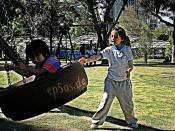PAIN MANAGEMENT IN CHILDREN
Adequate pain management should be viewed as an essential component of compassionate medical care of children. A child's developmental level frames the child's understanding of painful experiences. Cognition of the toddler: has the capacity for basic reasoning; understands object permanence; has the beginnings of memory; the understanding of causality; and begins to play "make believe". Toddlers language: vocabulary of over 20 words and can say two to three-word sentences. A three year old knows about 200 or more words. Cognition of the preschooler: believes there is a cause for everything; asks "why" about everything; does not understand time, no concept of the future; generalizes, mixes fact with fiction; thinks magically; has imaginary friends. The preschooler's language: can recite nursery rhymes; vocabulary of 1500 words; expresses in more complex terms; and good storyteller. Cognition of the school-aged child: mastered logical reasoning; can concentrate; delays gratification; knows a great deal about the environment; knows the function and names of the body parts; understands time; and generalizes from experiences.
The school-aged child's language: speech is well developed and expressive. Cognition of the adolescent: can deal with reality in an appropriate manner and use abstract thinking. The language of the adolescent is similar to that of the adult. Pain assessment scales should be used with children. For the three to seven year old there is the face scale, the color scale or the Oucher scale. For the child that is seven or older you can use the linear scales. For infants and toddlers observe their various behaviors: facial expressions, posturing, and vocalization or verbalization. Observation and assessment of the child is also important in the following areas: blood pressure, crying, movement and agitation. Assessment of pain in children is challenging. A high index of suspicion may be the most valuable...



Straightend me out
straight forward and to the point, your essay told me the facts that i needed to know with out the normal amount of useless wording that comes along with it
0 out of 0 people found this comment useful.